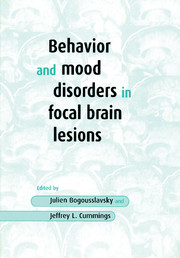Book contents
- Frontmatter
- Dedication
- Contents
- List of contributors
- Preface
- Acknowledgments
- 1 Emotional consequences of focal brain lesions: an overview
- 2 The evaluation of mood and behavior in patients with focal brain lesions
- 3 Methodological issues in studying secondary mood disorders
- 4 Emotional behavior in acute brain lesions
- 5 Depression and lesion location in stroke
- 6 Mood and behavior in disorders of the basal ganglia
- 7 Mania and manic-like disorders
- 8 Behavioral and emotional changes after focal frontal lobe damage
- 9 Disorders of motivation
- 10 Thalamic behavioral syndromes
- 11 Obsessive-compulsive disorders in association with focal brain lesions
- 12 Emotional dysprosody and similar dysfunctions
- 13 Temporal lobe behavioral syndromes
- 14 Neural correlates of violent behavior
- 15 Focal lesions and psychosis
- 16 Alterations in sexual behavior following focal brain injury
- 17 Anosognosia
- 18 Acute confusional states and delirium
- Index
15 - Focal lesions and psychosis
Published online by Cambridge University Press: 05 August 2016
- Frontmatter
- Dedication
- Contents
- List of contributors
- Preface
- Acknowledgments
- 1 Emotional consequences of focal brain lesions: an overview
- 2 The evaluation of mood and behavior in patients with focal brain lesions
- 3 Methodological issues in studying secondary mood disorders
- 4 Emotional behavior in acute brain lesions
- 5 Depression and lesion location in stroke
- 6 Mood and behavior in disorders of the basal ganglia
- 7 Mania and manic-like disorders
- 8 Behavioral and emotional changes after focal frontal lobe damage
- 9 Disorders of motivation
- 10 Thalamic behavioral syndromes
- 11 Obsessive-compulsive disorders in association with focal brain lesions
- 12 Emotional dysprosody and similar dysfunctions
- 13 Temporal lobe behavioral syndromes
- 14 Neural correlates of violent behavior
- 15 Focal lesions and psychosis
- 16 Alterations in sexual behavior following focal brain injury
- 17 Anosognosia
- 18 Acute confusional states and delirium
- Index
Summary
Introduction
Focal lesions leading to psychosis are relatively rare. For example, of 1821 men with focal brain lesions due to trauma, only 21 showed psychotic symptoms (six with paranoid psychosis and 15 with schizophrenia-like psychosis) (Hillbom, 1951). Lesions in many areas have been implicated in the causation of psychosis; however, there are no areas that, when lesioned, reliably produce psychotic symptoms. This chapter reviews the location of lesions that have been associated with psychosis and factors that contribute to the expression of psychosis. Lesions associated with psychosis found in epilepsy, stroke, demyelinating syndromes, neoplasms, trauma, and focally degenerative diseases are described. Conditions associated with psychosis and the brain regions commonly involved are summarized in Table 15.1.
Definitions
Psychosis has many possible definitions; the definition employed in this chapter is 'the inability to distinguish reality from fantasy with impaired reality testing and the creation of a new reality’ (Kaplan and Saddock, 1995) manifested by the presence of delusions or hallucinations. Other definitions of psychosis include impairment of personal and social functioning and thought disorder, but these qualities extend beyond the core syndrome and would include many patients with uncomplicated neurological disorders. Delusions will be defined as false beliefs based on incorrect inferences about external reality and firmly held in spite of evidence to the contrary (Cummings, 1995b). Hallucinations will be denned as sensory perceptions occurring without appropriate external stimulation of the relative sensory organ, and are only manifestations of psychosis if the perceiver believes them to be real. They will be included in this discussion only if the hallucinations are psychotic manifestations.
- Type
- Chapter
- Information
- Behavior and Mood Disorders in Focal Brain Lesions , pp. 419 - 436Publisher: Cambridge University PressPrint publication year: 2000
- 4
- Cited by



